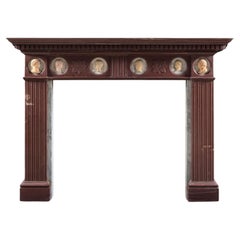Japanese Designed And Made Before 1700 Ad
Antique Early 19th Century English Empire Fireplaces and Mantels
Marble
People Also Browsed
Mid-20th Century Georgian Statues
Stone, Composition
Antique Late 19th Century German Rococo Vases
Porcelain
Antique Late 19th Century British Egyptian Revival Settees
Wire
Antique Early 19th Century British Regency Benches
Oak
Antique 18th Century French Louis XV Snuff Boxes and Tobacco Boxes
Gold
Antique 19th Century French Empire Architectural Models
Wood
Antique 1790s English George III Cabinets
Mahogany
Antique 19th Century Unknown Egyptian Revival Daybeds
Walnut
Antique Mid-18th Century Irish Side Tables
Mahogany
Antique Mid-19th Century English Center Tables
Amboyna, Wood
Antique 1820s Sterling Silver
Silver
Early 20th Century English Art Deco Fireplaces and Mantels
Marble
Antique 19th Century South American Other Arms, Armor and Weapons
Steel, Brass, Bronze
Antique 1780s Irish George III Fireplaces and Mantels
Marble, Statuary Marble
Antique 19th Century French Grand Tour Planters, Cachepots and Jardinières
Marble, Silver Plate, Bronze
Antique 19th Century English William IV Dining Room Chairs
Leather, Mahogany
A Close Look at Empire Furniture
From 1804–15, Napoléon I reigned as the emperor of France, bringing the country into a new era of opulence after the fall of the monarchy and the tumultuous years of the French Revolution. He declared, “We must have very solid things, made to last 100 years.” Empire-style furniture followed suit, with imposing pieces constructed from mahogany and adorned with gilded ornaments. Expanding on the neoclassicism popularized in the previous century — such as in Louis XVI style — Empire style borrowed from the great civilizations of antiquity, from Egypt to Greece and Rome, to connect this nascent empire to the power of the past.
Napoléon I believed the production of fine furniture would reflect the stature of the republic, with his official architects Charles Percier and Pierre-François-Léonard Fontaine leading the way with their work on his residences.
Luxurious materials, symmetrical shapes and bold colors characterize antique Empire-style bedroom furniture, armchairs, cabinets and other structures, with frequent motifs including mythological creatures, geometric designs, acanthus leaves, eagles, bees (the imperial emblem) and swans, a favorite of Empress Joséphine.
Flat surfaces, like marble tabletops, were accented with decadent details, such as the bronze furniture mounts made by sculptor Pierre-Philippe Thomire for the French palaces. Martin-Guillaume Biennais, who worked as the imperial goldsmith, crafted intricate luxury objects that mixed wood, fine metal, mother-of-pearl and ivory. Ormolu — or elaborate bronze gilding — was essential to French design in the 18th and 19th centuries as a cornerstone of the neoclassical and Empire styles.
The style became popular abroad, influencing the American Empire style. Stately pieces carved with sprigs of olives by cabinetmaker Pierre-Antoine Bellange were acquired by American President James Monroe for the White House in 1817.
Find a collection of antique Empire tables, lighting, seating and other furniture on 1stDibs.
Finding the Right Fireplaces-mantels for You
While we likely wouldn’t mourn the invention of home heating and air-conditioning, these innovations did tragically reduce the widespread need for fireplaces and mantels in our living rooms.
Once an essential fixture in all homes, the fireplace, which, along with the chimney, is as old as the Middle Ages, was actually rendered redundant with the advent of the cast-iron heating stove during the 18th century. Victorian-era heating stoves were popular in the common areas of a living space for their capacity to heat as well as for their lack of smoke compared to fireplaces. However, improvements in craftsmanship as well as the Industrial Revolution meant that fireplaces were evolving in form and functionality.
Even as HVAC systems would eventually see to it that fireplaces weren’t a necessity, no mechanically engineered thermal heating and ventilation technology can replicate the feeling of warmth and camaraderie that a flickering fire guarantees. We just love a good fireplace.
“With antique fireplaces, you get heart, soul, character and architecture,” says Tony Ingrao, a Manhattan-based interior designer who purchased an important 16th-century French limestone fireplace for a client’s Greenwich Village townhouse.
Vintage fireplaces and mantels have earned their coveted position as desirable focal points in any room over the course of a staggering evolution in design that has yielded everything from intricately carved works of limestone to sleek works of wood paneling and rolled steel.
As log after log turns into ash, these iconic designs prove their timelessness and value, monetarily and as prized decorative monuments. Whether you seek to simply warm a space or completely transform it, an eye-catching new mantel for your blazing hearth — be it an elegant neoclassical design, a marvelous work of marble in the Louis XV style or an unconventional contemporary variation — is the perfect solution.
Find a collection of antique and vintage fireplaces and mantels on 1stDibs today.
